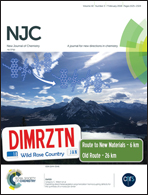Investigation of the retention characteristics of a 26-membered aromatic-aliphatic azamacrocycle bonded silica gel stationary phase for high performance liquid chromatography
Abstract
A new supramolecular host-bonded stationary phase for high-performance liquid chromatography (HPLC) was prepared by coupling a 26-membered aromatic-aliphatic-mixed azamacrocycle to 3-chloropropyltrimethoxylsilane-modified silica, which was characterized by infrared spectroscopy and elemental analysis. To understand the role of functional groups and the nano-sized cavity on the azamacrocycle for its chromatographic performance, the chromatographic behavior of the new stationary phase was investigated by using alkylbenzenes, polycyclic aromatic hydrocarbons (PAHs), aromatic amines, and aromatic positional isomers as probes. This stationary phase exhibited a unique chromatographic retention, which was characterized by multiple interactions between the stationary phase and analytes, including hydrophobic, π–π, hydrogen-bonding, and inclusion interactions. At the same time, the embedded azamacrocycle showed remarkable superiority over the C18 phase in terms of shape, planarity, and isomeric recognition in discriminating specific PAHs and isomers and overcoming the negative effect of residual silanol groups. Such a hybrid stationary phase is more versatile and shows great potential in the analysis of complex samples.



 Please wait while we load your content...
Please wait while we load your content...